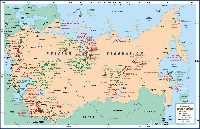FSU/ Eastern Europe: Turkmenistan
August 2000 Vol. 221 No. 8 International Outlook FSU/EASTERN EUROPE Interfax Petroleum Agency, Moscow Turkmenistan Most of Turkmenistan’s oil and g
FSU/EASTERN EUROPEInterfax Petroleum Agency, Moscow TurkmenistanMost of Turkmenistan’s oil and gas reserves are concentrated in two areas: Amu-Darya (63% of gas reserves) and South-Caspian (73% of oil reserves). Turkmenistan’s strategy calls for raising production to 560,000 bopd and 8.22 Bcfgd by 2005, according to a program approved by parliament late last year. Turkmenistan is showing more interest in developing its Caspian Sea sector, where oil reserves rose sharply after an evaluation by Turkmen officials and Western Geophysical. The Caspian sector now contains an estimated 80 billion bbl of oil (proved, probable and possible), up from 47.3 billion bbl. Gas reserves remain at 194 Tcf.
Garashsyzlyk is Turkmenistan’s largest onshore block, accounting for 75% to 80% of all oil production. Remaining recoverable oil reserves are estimated at 725 million to 2.2 billion bbl. However, substantial additional reserves are suspected in the lower horizons, where seismic work is underway. Production/drilling. The country produced 2.22 Bcfgd, and 139,425 bpd of oil and condensate in 1999 from 46 fields. Output was up 70% for gas, 13% for oil and 33% for condensate. Officials plan to produce 4.5 Bcfgd and about 200,000 bopd this year, including 39,835 bopd from Petronas, Dragon Oil, Monument and ExxonMobil. Turkmenistan expects to boost oil production substantially with a number of projects to maintain reservoir pressures. Application of gas-lift methods will be possible, once the Serdar compressor station at Barsa-Gelmes field comes online in December. Capital repairs will be carried out at over 570 idle wells. These wells will contribute about 140,000 bopd and 677 MMcfgd. A wildcat drilled to 6,560 ft in the Mydar section of Central Karakumy produced 1,455 bopd. This portion of the Kyrkskaya field group is explored by subsidiaries of state-owned Turkmengaz. Exploration drilling this year at Toreshikh field in the south yielded heavy gas flows. In the west, over 40 wells will be drilled this year, boosting drilling there to about 279,000 ft. Capital repairs to wells at Koturdepe, Gogradgag and Burun fields continue. So far, 30 wells have been reactivated. Meanwhile, state-run Turkmengeologiya is exploring the Miaser, Akeser and Porsu structures. These small prospects are along the Korpedzhe-Kord-Kuy gas pipeline. Drilling of 10 wells to 13,125 ft is planned. Projects. A number of PSA projects are active. Petronas Carigali operates offshore at Barinova, Gubkina and Livanova fields. An alliance of Monument Oil & Gas and ExxonMobil is operating at Nebit-Dag and Garashsyzlyk fields. Dragon Oil has invested $35 million to develop LAM and Zhdanov fields offshore. The project is reconstructing 12 offshore platforms, and renovating trunk oil pipelines, plus oil storage and refining infrastructure at Aladzha. The firm also will build a 363,500-bbl storage facility. The work will boost throughput, allowing daily output to rise ten-fold, to 73,000 bopd. Recoverable reserves at the two fields are roughly 580 million bbl of oil, based on Turkmen estimates. Dragon Oil plans to raise output over seven years to about 100,000 bopd. The company is working with Petronas to draw up plans for utilizing the associated gas. The Cheleken joint venture produced 6,850 bopd last year, of which Dragon Oil received 3,285 bopd. Operator ExxonMobil and partners, Lasmo and Turkmenneft, began seismic work at Koturdepe and Barsa-Gelmes oil fields onshore. The group has rights to develop the lower horizons. Turkmenneft is developing the shallow reservoirs, alone. Surveys at Koturdepe and Barsa-Gelmes will cover more than 115 sq mi. Royal / Dutch Shell is negotiating five PSAs covering Akerem, Malai, Shatlyk, Naip and Garashsyzlyk gas fields. Shell earlier studied plans to build a pipeline to Turkey, through Iran, and prepared the feasibility study, but suspended the work in favor of the Trans-Caspian pipeline project. A Lasmo-Mobil group will keep investment this year for Burun field development (part of the Nebit-Dag project in the west) at 1999’s $54-million level. The contract area includes five producing fields. However, their output has fallen from 8,175 bopd in early 1999 to about 7,300 bopd currently. Turkmen President Saparmurad Niyazov has approved a $55-million
Turkmengeologiya project to develop new fields in the east. To speed the start, Turkmengeologiya will operate
it in phases. Turkmenneftegazstroi will explore at Tagtarbazar field during 2000 and 2001. President Niyazov
has also approved a $38.5-million Turkmengaz project at Kirpichly gas / condensate field, to upgrade gas
production technology. Turkmenneft has begun an $86-million development of South Kamyshlydzha field. Two
exploration wells and five production wells are being drilled to confirm reserves. The field has 10 wells now.
Production should reach 20,000 bopd in 2004.
|
|||||||||||||||||||||||||||||||||||||||||||||||||||||||||||||||||||||||||||||||||||||||||||||||||||||||||||||||||||||||||||||||||||||||||||||||||||||||||||||||||||||
- Applying ultra-deep LWD resistivity technology successfully in a SAGD operation (May 2019)
- Adoption of wireless intelligent completions advances (May 2019)
- Majors double down as takeaway crunch eases (April 2019)
- What’s new in well logging and formation evaluation (April 2019)
- Qualification of a 20,000-psi subsea BOP: A collaborative approach (February 2019)
- ConocoPhillips’ Greg Leveille sees rapid trajectory of technical advancement continuing (February 2019)



